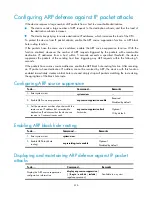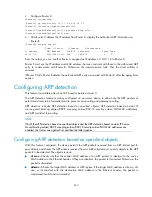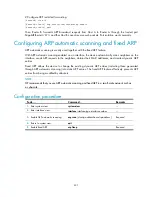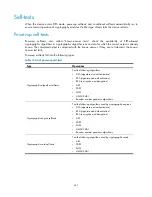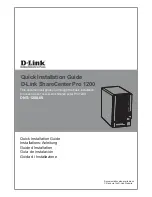
429
# Add local access user
test
.
[RouterB] local-user test
[RouterB-luser-test] service-type lan-access
[RouterB-luser-test] password simple test
[RouterB-luser-test] quit
# Enable ARP detection for VLAN 10.
[RouterB] vlan 10
[RouterB-vlan10] arp detection enable
# Configure the upstream port as a trusted port and the downstream ports as untrusted ports (a port is an
untrusted port by default).
[RouterB-vlan10] interface gigabitethernet1/0/3
[RouterB-GigabitEthernet1/0/3] arp detection trust
[RouterB-GigabitEthernet1/0/3] quit
After the preceding configurations are complete, when ARP packets arrive at interfaces
GigabitEthernet1/0/1 and GigabitEthernet1/0/2, they are checked against 802.1X security entries.
ARP restricted forwarding configuration example
Network requirements
As shown in
, Router A acts as a DHCP server. Host A acts as a DHCP client. Host B's IP
address is 10.1.1.6, and its MAC address is 0001-0203-0607. Port isolation configured on Router B
isolates the two hosts at Layer 2, which can communicate with the gateway Router A.
GigabitEthernet1/0/1, GigabitEthernet1/0/2, and GigabitEthernet1/0/3 belong to VLAN 10. Router
B is enabled with DHCP snooping and has ARP detection enabled in VLAN 10.
Configure Router B to still perform port isolation on ARP broadcast requests.
Figure 149
Network diagram for ARP restricted forwarding configuration
Router A
Router B
Host A
Host B
GE1/0/3
Vlan-int10
10.1.1.1/24
Gateway
DHCP server
GE1/0/1
GE1/0/3
GE1/0/2
VLAN 10


